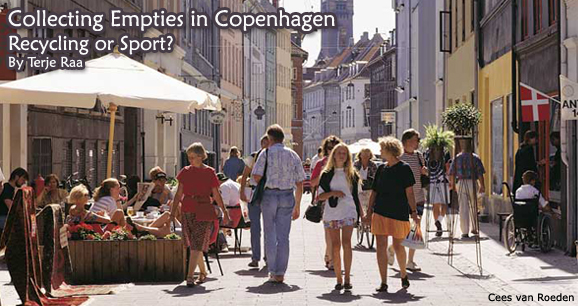

A Popular Sport In Denmark
Collecting returnable bottles and cans to make some money on the side is a popular sport in Denmark, peaking on hot summer days, with the City Hall Square in Copenhagen as its foremost arena.
The spacious shell-shaped square is lined with green benches, 80 in total, every other one equipped with a circular trash bin. That means 40 possibilities of finding empties that once contained beer or mineral water, fizzy drinks or alcopops.
Most people don’t care about the deposit they paid, especially after drinking alcohol, the intake of which is another traditional Danish sport.
Searching for empties is a free-for-all. What it takes is a plastic bag or two. However, many work on a larger scale, sporting rucksacks and little trolleys.
A certain degree of discretion is appropriate, but that comes automatically, as collecting is not exactly prestigious, although recycling is one side of it. Often, it’s a sport you choose out of necessity.

How People React
People on the benches react differently when the collectors approach: some look the other way, displaying embarrassment and disdain.
Others get irritated because the relentless collectors never seem to tire and also empty out residue on the flagstones.
A third group curiously follows the collectors’ endeavors, while a few drink up and hand them their beverage containers. Gathering reusables is definitely not a spectator sport.
About 1.7 million people live in the Greater Copenhagen area. Denmark’s capital is located on the eastern shore of the island of Zealand (Sjælland) and partly on the island of Amager.
København — this is its Danish name — faces the Øresund, the strait of water that separates Denmark from Sweden and also connects the Baltic Sea with the North Sea.
The Rådhuspladsen, or City Hall Square, surrounded by fine old buildings up to six floors high with a few modern exceptions, is perfect for taking a break.
The City Hall
Most spectacular is the City Hall, or Rådhustårnet, an elegant red brick building inspired by Italian Renaissance and completed in 1905. It sports the tallest spire (346 feet; 106 m) of all in this city of slender towers.
The dark glass building opposite is an oversized ticket-office for the local yellow buses. But its most important function you will find downstairs: public toilets.
Good weather is not a matter of course in Copenhagen. Precipitation is evenly distributed over the year.
On wet days, the City Hall Square is dominated by the flow of cars on either side of it and a stream of umbrellas moving across it between the pedestrian mall Stroget and Vesterbrogade Street.
A large thermometer, adorning one street corner, fails to climb up to two decorative golden ladies — one on a bicycle, the other carrying an umbrella.
The figurines are supposed to be out one at a time depending on the weather, which is so ever-changing and unpredictable that they often decide to stay in their doorways.
The picture changes completely on a warm and sunny day, when the square is invaded by happy faces thirsting for beer and sunshine, to the delight of those collecting bottles and cans.
The empties originate from two open-air cafés, three hot-dog stands, an ice cream vendor and a 7-Eleven across the street.
Despite the alcohol consumption, the overall atmosphere is peaceful, except for an unsettled battle between evil and good in the water-spouting Dragon Fountain.
The Collectors
The collectors might be expected to circle around searching the trash bins one by one, but they do not. Each has his or her special strategy, depending on where the crowd is and where their fellows are in action.
One of the most faithful is a short elderly woman wrapped up in dark trousers and a long grey jacket, a scarf on her head and a straw hat on top of it.
She is always mumbling, either because of her apparently aching feet, discontentment with her yield or Danish society in general.
Carlsberg, the world renowned Danish brewery, does its best to stimulate people’s thirst — by advertising on the building facades and by having two strong horses, with long fair manes, slowly pull an old-fashioned brewer’s dray past.
Others are more modest in their money-making efforts, like three boys who unfold a black-and-white dance floor for their breakdance routine, soon outdone by three Latin American men on flutes and guitar and a girl selling their CD’s.
If champagne bottles brought in a deposit, collectors would certainly approach the newlyweds.
Two of them — a male couple — are just leaving the Wedding Hall with their wedding papers in a red envelope. Family and friends receive them with flying rice and champagne.
Climbing the City Hall clock tower is incompatible with alcohol consumption. The view is impressive, though, and includes the entire Copenhagen area as well as the Øresund Bridge.
The huge clock right above is a national symbol whose bells take over every Danish radio at 12 a.m.

Collecting Can Be A Style Too
Collecting empties can actually be done with style and without losing one’s self-respect. A middle-aged lady, accompanied by her tiny dog, seems quite pleased with the way things are.
Sporting dark-dyed hair, lots of gold in her ears and dressed in purple trousers and an elegant dark jacket, she roams the square with a trolley and two big cases.
She knows that collecting bottles and cans, like any other sport, requires enthusiasm to give results. “G’day!” she beams, truly proud that one case is already full. “I did that in just one hour!”
If You Go
The Official Travel Guide to Denmark
www.visitdenmark.com
- The Low-Key Magic of Ghent, Belgium - April 22, 2024
- Discover the Hidden Charm of Extremadura in Spain - April 20, 2024
- Life of a Champion: Exploring the Muhammad Ali Center in Louisville - April 19, 2024
